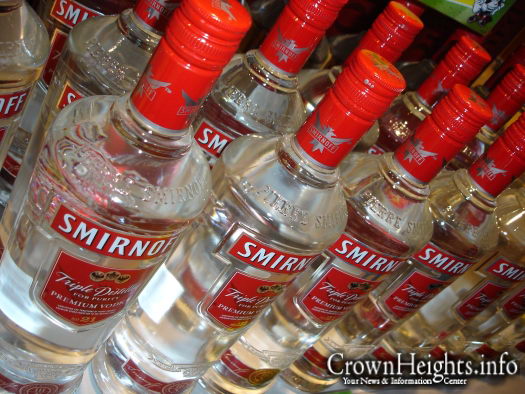
LA Rabbis Caution on Alcohol During Simchas Torah
Dozens of men sit around a few tables, humming a soft Chasidic niggun, swaying slowly back and forth, noshing on cold cuts, salads and light snacks. Some are sipping on small cups of vodka. Most wear white dress shirts, black dress pants and a long black coat.
This is a Chabad-Lubavitch farbrengen, and save for the brand-name foods and Styrofoam plates, it’s a scene that has been re-created countless times for centuries around the world. Yiddish for “joyous gathering,” this particular farbrengen took place after Shabbat morning services earlier this summer at Congregation Levi Yitzchok in Hancock Park.
“Think of it as a Kiddush, a sit-down Kiddush,” albeit one with its own unique Chasidic twist, said Rabbi Gershon Schusterman, a regular at Levi Yitzchok.
Farbrengens, conducted thousands of times per year at Chabad houses across the world, are one of the movement’s favorite methods for transmitting wisdom — through Chasidic stories, personal experiences and teachings from previous leaders (rebbes) of the Chabad movement. Every element of the celebration is meant to encourage one thing, according to Rabbi Mendel Greenbaum, a Levi Yitzchok attendee: “to inspire one in the service of HaShem.”
Alcohol appears in moderation, he said, to assist attendees find inspiration that may help them improve their connection to God and Judaism.
“Alcohol is not the driving factor of the farbrengen. You can have a wonderful farbrengen without any alcohol,” Greenbaum said. “At times the function of a little bit of alcohol will help them rise past their certain inhibitions or challenges or be able to help them in the process.”
In Shusterman’s words, alcohol can help people be more “receptive” to the ideas being discussed.
A normal farbrengen, part of holidays and lifecycle celebrations, is low-key, with drinking ranging from none to at most a few l’chaims and quiet tunes sung with everyone seated. Come Simchat Torah, though, that all changes.
At Levi Yitzchok and dozens of other congregations across Los Angeles, the alcohol will be flowing, food will be piled high, feet will be sore from dancing, and most, if not all, the tunes will be sung loudly. In fact, the partying at Levi Yitzchok will begin the night before Simchat Torah, on the evening of the holiday of Shemini Atzeret, when the congregation will perform hakafot (reading prayers while carrying a Torah around the bimah) and eat a festive meal under the sukkah.
Save for sleeping, eating and some occasional traditional praying, the beginning of Shemini Atzeret until the end of Simchat Torah is, according to Greenbaum, an “ongoing farbrengen for 48 hours.”
As a preemptive caution for parents heading into the holiday, heads of school from four local Orthodox high schools (YULA Boys, YULA Girls, Shalhevet and Valley Torah) wrote an e-mail to parents to look after their children on Simchat Torah.
In a phone conversation with the Journal, the head of school of Shalhevet, Rabbi Ari Segal, said that while its nice “when a shul can have alcoholic beverages served in a responsible way,” he hopes that parents and community members model “normal alcoholic consumption” for area youths.
“We are not waiting until someone ends up in the hospital with alcohol poisoning,” Segal said. “They [minors] are kind of trying to imitate the adult behavior I see, but without the level of responsibility and care.”
Rabbi Dov Emerson, the head of school of YULA Boys, wrote to the Journal in an e-mail that the high school plans to host about 150 students, parents, rabbis and relatives for hakafot and a holiday meal on Simchat Torah evening that he said would be safe and uplifting.
At Levi Yitzchok, Greenbaum said that a few hundred men will gather on Sept. 27 at the close of Simchat Torah to sing melodies that have passed down through Chabad over hundreds of years. With a packed house and an intensely celebratory holiday winding down, it won’t resemble in style Levi Yitzchok’s typical, laid back Shabbat farbrengen. But its purpose — to help people overcome their spiritual and religious challenges by bringing together Jews to eat and sing — will be exactly the same.
“It’s easier to battle the yetzer hara [evil inclination] when you have a few yetzer tovs [good inclinations] working together,” Greenbaum said.
















psy
thankyou. and make sure that parents, friends, rosh yeshivas, rebbes, etc, make sure to mention how to drink, and how to go about Simchas Torah. Maybe that will help a bit.
californian
bs”d
the only warning about mashke that i saw here ( correct me if im wrong) was from veltish(not lubavitch) people/rabbis
btw. why no mention of the gzairah from the rebbe?
a gut yom tov
Mashkah
Mashkah ruines peoples lives Why is it given out like water???????
Milhouse
Mashke also enhances people’s lives. It’s a miracle drug, a gift from Hashem, good for the body and the soul. It must not be abused, but it must certainly not be rejected.
The kavonoh the Alter Rebbe gives for spilling the makkos at the seder is about using alcohol responsibly, applying the power of בינה to separate and reject the aspect of אף וזעם in alcohol, while keeping the rest, which is יין המשמח.
There is also the moshol of the seven animals, in the medrash on parshas Noach, which we are now learning. The first few drinks are wonderful and positive. Then they start to deteriorate, until they start to do harm rather than good.